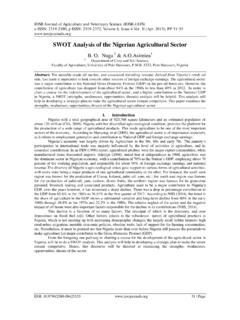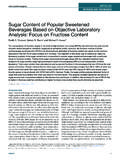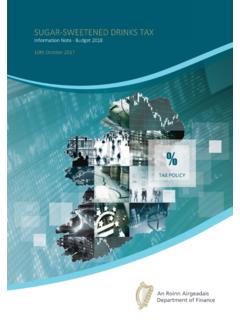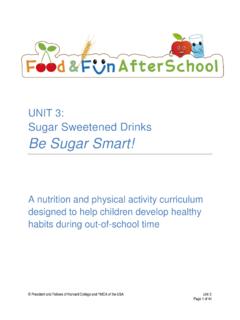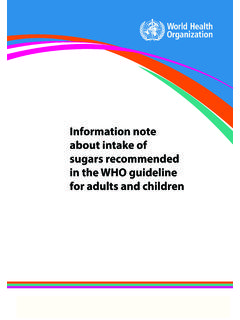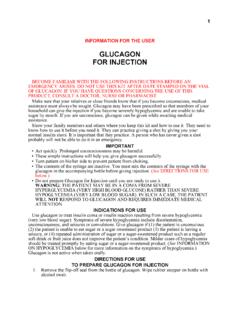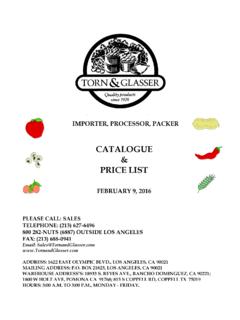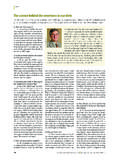Transcription of Using Refractometer to Determine the Sugar …
1 IOSR Journal of Applied Chemistry (IOSR-JAC). e-ISSN: 9, Issue 7 Ver. I (July 2016), PP 89-91. Using Refractometer to Determine the Sugar Content in Soft Drinks Commonly Consumed In Abakaliki, Nigeria OTI, Wilberforce J. O. Department of Industrial Chemistry, Ebonyi State University, Private Mail Bag 053, Abakaliki, Ebonyi State, Nigeria. Abstract: Consumption of Sugar sweetened beverages (SSBs), particularly carbonated soft drinks may be a key contributor to the epidemic of diabetes by virtue of these beverages high' added Sugar content, low safety and incomplete compensation for total energy. The Sugar content in some selected soft drinks was analyzed Using hand-held Refractometer . The results revealed that the content of sucrose per bottle in Amstel malt, Malta Guinness, Grand malt, Fayrouz, Teem, Bitter lemon, Beta malt, Maltina and Maltex were: , , , , , , and respectively.
2 From the result obtained, the Sugar levels were of the order Fayrouz < Amstel Malta < Teem Bitter lemon < Malta Guinness < Maltina / Beta malt < Maltex <. Grand Malt. The highest Sugar concentration was observed in grand malt while the lowest was in Fayrouz soft drink. This suggests that consumers of fayrouz are least likely to be exposed to high Sugar related health issues. Keywords: Sugar , Sweetener, Soft Drink, Malt, Refractometer , Abakaliki, I. Introduction Soft drink is a non alcoholic beverage that typically contains carbonated water, a sweetener and a natural or artificial flavouring agent and any other additives such as caffeine, colorant, preservatives etc. The sweetener used in preparing soft drinks may be Sugar , high fructose corn syrup, fruit juice or some combination of these [1].
3 Sugar belongs to class of food substance known as carbohydrate which is composed of carbon, hydrogen and oxygen. It is the generalized name for sweet short-chain soluble carbohydrate, many of which are used as food. Sugar performs a variety of functions in food products such as provision of sweet taste and flavour to beverages, acting as preservative where Sugar inhibits the growth of microorganism [2]. It is important to note that Sugar contains no nourishment rather it only contains calorie which is liable to make people fat. Overweight people are more likely to develop high blood pressure and eventually heart attack. Malt drink is an unfermented non alcoholic beverage commonly consumed in the Caribbean island, Latin America and Africa especially in Nigeria.
4 Historically, malt drink was used as food for children and the sick, but has since become a main stream beverage consumed by people especially during festive periods. Most importantly, malt-based drinks have developed a reputation over the centuries for their nutritional values, a message that is an attractive for manufacturers to carry across in today's climate of increasing health awareness [3]. Malt thrives in Nigeria because many Muslim population and some Christian groups forbids the drinking of alcohol. The consumption of Sugar -sweetened soft drinks is associated with obesity, type 2 diabetes, dental decay, kidney stone and low nutrient levels. Many caffeinated soft drinks have been linked to anxiety and sleep disruption when consumed in excess.
5 Also sodium benzoate used as preservatives has been investigated by researchers as a possible cause of DNA damage and hyperactivity [4]. For many years, the alternative to Sugar is the use of chemicals such as saccharin and cyclamates which are sweeter than natural sugars but do not have the calories of Sugar . However tests on laboratory animals rather suggest that both chemicals are possible cause of cancer [5]. ln Nigeria, Standards Organization of Nigeria (SON) sets the standards for regulating the quantity of Sugar and other ingredients in soft drinks [6]. Hand Refractometer is an instrument for measuring refractive index which is widely used for measuring the Sugar concentration of sugarcane, syrups, jams etc. It is easy and quick and requires only few drops of sample liquid in the main prism and the percentage value is immediately read out.
6 By shinning a beam of light through a sample of liquid, Refractometer measures the amount of liquid that is refracted from the light path due to the constituents in the sample [7]. The device takes the refraction angle and correlates them to already established refractive index which then evaluates the concentration of solutions. The purpose of this work therefore was use Refractometer to measure Sugar concentration in selected soft drinks commonly consumed in Abakaliki, Nigeria. II. Materials And Methods Sample Collection Sample of soft drinks were collected from their respective bottles. The entire products used for these works were registered and licensed in Nigeria by their respective companies and they all had NAFDAC. DOI: 89 |Page Using Refractometer to Determine the Sugar Content in Soft Drinks Commonly Consumed numbers.
7 Each samples collected from different soft drink was poured into 500 mL beaker and with the aid of magnetic rod and magnetic stirrer the samples were stirred for 10 minutes during which gases within the samples were removed and the degassed process was complete. Brix value is a specification parameter for beverages and it was obtained by conducting Brixt test. This is normally done by calibrating the Refractometer Using distilled water or brix solution. The Nimatic Brix Refractometer flip was opened and washed with distilled water and then cleaned with a tissue paper; the calibration adjuster was adjusted to zero before dropping the sample on the slide. Few drops of the degassed sample were dropped on the slide Using a dropper and the flip was covered.
8 The reading was taken at steady value. Densitometer was used to measure the densities of the samples of the soft drink. The device was first calibrated with distilled water and the sample was used to flush out any impurity in the compartment for three times before the sample was introduced into the tube. The reading was taken through the eye piece focus under a light ray when the value becomes steady. Analysis was done in triplicate. III. Calculation From the volume of the soft drink and the values obtained from Refractometer and densitometer, mass of Sugar was obtained. This was done following a method described by [8]. The mass of Sugar in a bottle of soft drink is calculated as follows: Volume of soft drink (from label and direct confirmatory measurement) = v Density of soft drink (from densitometer) = y % Sugar (brix value from Refractometer ) = z Mass of soft drink (a) = y x v % of Sugar in soft drink (z) = (Mass of soft drink (a) x 100) / Mass of Sugar (1).
9 All values in Eq. (1) are known except mass of Sugar . Mass of Sugar = (a x z) / 100. Mass of Sugar = (Mass of soft drink x % of Sugar in soft drink) / 100 (2). This equation (2) was used to obtain the mass of Sugar in each sample bottle. IV. Result Table 1 and Fig 1 present the mean percentage of Sugar in the investigated soft drinks. Samples (300 mL) 1st Test 2nd Test 3rd Test Total Value Mean SD Sugar content (g per bottle). Teem Biter lemon Malta Guinness Fayrouz Amstel Malta Beta Malt Grand Malt Maltina Maltex V. Discussion From the result obtained, the Sugar levels were of the order Fayrouz < Amstel Malta < Teem Bitter lemon < Malta Guinness < Maltina / Beta malt < Maltex < Grand Malt. Similar work done in Abakaliki for different soft drinks other than malts, by Aloh et al.
10 , (2015), [5], agree with the fact that Sugar level in soft DOI: 90 |Page Using Refractometer to Determine the Sugar Content in Soft Drinks Commonly Consumed drinks varies. The results obtained from this work are comparable to those observed by Obuzor and Ajaezi (2010), [9], where the Sugar level was in the order Amstel Malta < Hi-Malt < Maltina < Grand malt < Malta Guinness. Of all the investigated soft drinks, only Grand malt most accurately represented the percentage Sugar level based on nutrition facts listed on the label. The percentage of Sugar in samples of Teem, Bitter Lemon, Malta Guinness, Fayrouz, Amstel Malt, Beta Malt, Maltina and Maltex were found to be lower than what was listed on the nutrition facts. The result from the analysis does not mean that manufacturers did not produce their soft drink brands in compliance with the standard but it does suggest that different analytical equipment used in determining percentage of Sugar in soft drinks may have different sensitivity and hence the results varied.









